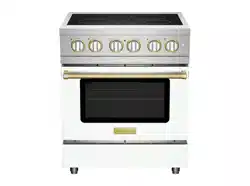Loading ...
Loading ...
Loading ...

30 (800) 449-8691
Cooking Guide and Tips — Convecon Cooking
Convecon Cooking
Convecon cooking uses a fan inside the oven to circulate the
heated air more evenly, resulng in beer heat distribuon
and a more consistent temperature. In general, convecon
roasng takes less me at lower temperatures than tradional
roasng.
For best results:
• As a general rule, reduce the temperature 25° F (-4° C) or
reduce the amount of me by 25% from that used in a
standard/convenonal oven. Cooking me may also be
shorter. Closely monitor the rst batch of each recipe
prepared.
• Cooking mes and temperatures will vary depending upon
such factors as size of the load, temperature, mixture of
ingredients (parcularly moisture), and density.
• Center pans on racks and load each shelf evenly to allow
for proper air circulaon within the oven.
• Select a roasng dish that has no or low sides, like a broiler
pan, so that the air can circulate freely around the food.
• When thawing frozen casseroles, preheat the oven 100° F
(38° C) over the suggested temperature. Return the
cooking temperature to the normal seng once the oven
is loaded. This will help compensate for the large frozen
casserole.
• Covered dishes do not benet from convecon baking or
roasng.
• Place mun pans in the oven back to front or with the
short side of the pans facing the front. This will result in
the most evenly baked food.
Convecon Baking
Convecon ovens can handle larger loads than standard ovens
with a high degree of consistency. In a convecon oven, cool
air is quickly and consistently replaced by hot air, which pro-
vides beer browning of baked goods and poultry. Meats are
seared and self-basted, which result in more avor and less
shrinkage as well as quicker cooking mes.
Important: You may nd that your new oven cooks dierently
than the old one. Take a few weeks to get comfortable and
familiar with your new oven. Do not use thermostats such as
those found in grocery stores to check your oven tempera-
tures. These thermostats may vary by 40° F (22° C) or more.
Loading ...
Loading ...
Loading ...
